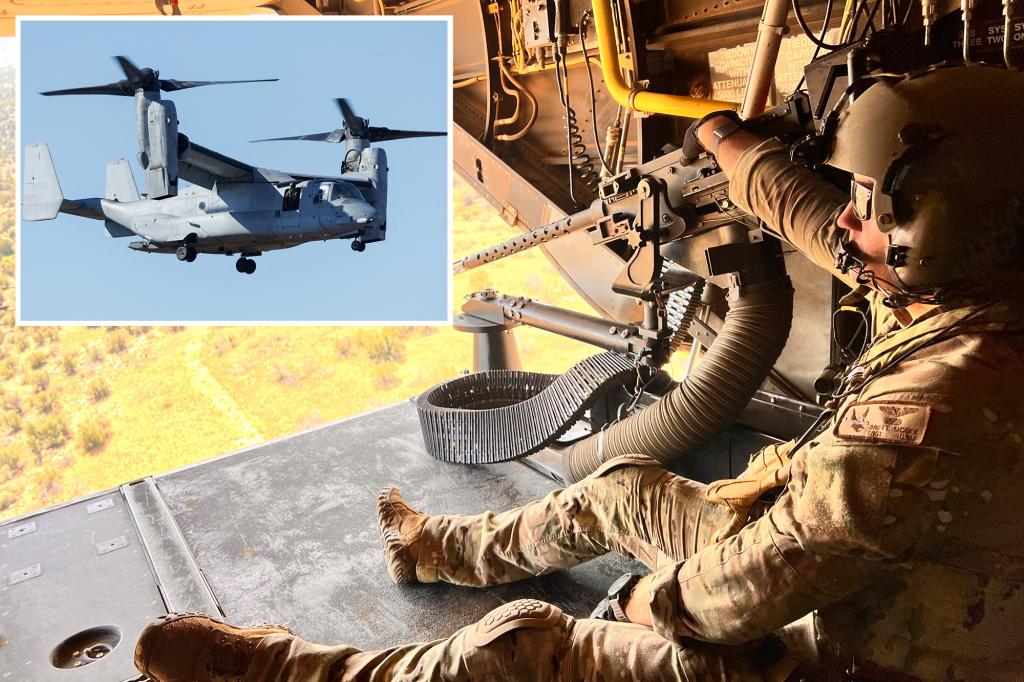The V-22 Osprey, a tiltrotor aircraft combining helicopter and airplane functionalities, has been grounded temporarily following a near-crash incident at Cannon Air Force Base in New Mexico in November 2023. This decision, recommended by Vice Adm. Carl Chebi, head of the Naval Air Systems Command, stems from concerns about weakened metal components potentially contributing to the near-disaster. The Marine Corps, Navy, and Air Force have all complied with the recommended pause, initiating investigations into the recurring issue of metal fatigue in the aircraft. This recent incident mirrors a fatal crash off the coast of Japan in 2022, which tragically claimed the lives of eight Air Force Special Operations Command personnel. Both incidents have highlighted a critical vulnerability in the Osprey’s transmission system, specifically within components made of a metal alloy called X-53 VIMVAR.
The investigation into the Japan crash revealed that microscopic weak spots, known as inclusions, within the X-53 VIMVAR alloy led to the catastrophic failure of a critical gear in the transmission. These inclusions, likely introduced during the manufacturing process, resulted in multiple cracks in the gear before its ultimate failure mid-flight. The aircraft’s crew, unaware of the severity of the damage, did not attempt an immediate landing, ultimately leading to the crash. In contrast, the crew involved in the New Mexico incident, having learned from the Japan tragedy, promptly landed the aircraft upon receiving similar warning signals, successfully averting a disaster despite losing an engine. The prompt action of the crew underscores the importance of lessons learned from prior incidents and the critical role of effective communication and training in mitigating risks associated with complex aircraft systems.
The recurrent issue of metal fatigue in the Osprey’s transmission system has raised serious concerns about the aircraft’s long-term reliability and safety. The near-crash in New Mexico, mirroring the circumstances of the fatal Japan crash, suggests a systemic problem that requires comprehensive investigation and remediation. The temporary grounding of the Osprey fleet provides an opportunity for a thorough assessment of the aircraft’s design, manufacturing processes, and maintenance protocols. This pause will allow engineers and investigators to determine the root cause of the metal fatigue issues and identify appropriate corrective actions to ensure the safety and reliability of the Osprey fleet.
The grounding of the Osprey fleet comes in the wake of an investigation by The Associated Press, which revealed a history of safety concerns plaguing the aircraft program. The AP report highlighted a pattern of premature wear and tear in critical components, further raising questions about the aircraft’s long-term sustainability and the adequacy of its maintenance procedures. The report also highlighted the potential role of the Osprey’s complex tiltrotor design in contributing to some of the accidents. Lawmakers, responding to the AP report, have urged Defense Secretary Lloyd Austin to ground the Osprey fleet until the identified safety and design issues are adequately addressed. This pressure from Congress underscores the growing concern over the Osprey’s safety record and the need for decisive action to prevent further incidents.
The ongoing investigation into the Osprey’s metal fatigue issue involves both the military and Bell Flight, the aircraft’s manufacturer. The primary focus is on identifying and implementing measures to strengthen the X-53 VIMVAR alloy and prevent future failures. Potential solutions include refining the manufacturing process to minimize inclusions, implementing more rigorous quality control measures, and developing enhanced inspection techniques to detect early signs of fatigue. The collaboration between the military and Bell Flight is crucial to ensure a comprehensive and effective solution to this recurring problem.
The V-22 Osprey, despite its unique capabilities and operational advantages, has a troubled history marred by accidents and safety concerns. Since its first flight in 1989, the Osprey program has been linked to the deaths of 64 personnel and injuries to 93 others. The recent near-crash in New Mexico, echoing the tragic events in Japan, reinforces the urgency of addressing the underlying issues that continue to plague this complex aircraft. The temporary grounding of the Osprey fleet provides a critical window of opportunity to conduct thorough investigations, implement necessary corrective actions, and restore confidence in the safety and reliability of this vital military asset. The future of the Osprey program hinges on the ability of the military, Bell Flight, and other stakeholders to effectively address these challenges and ensure the long-term safety and operational effectiveness of the aircraft.










